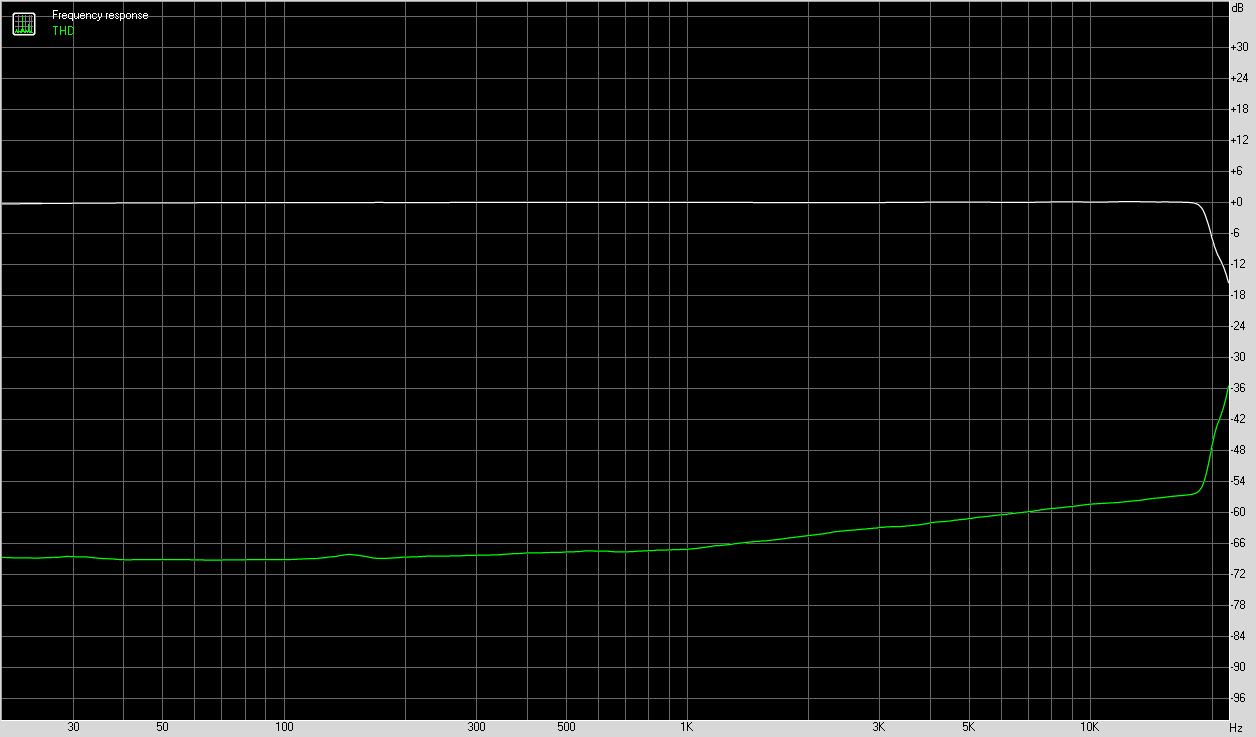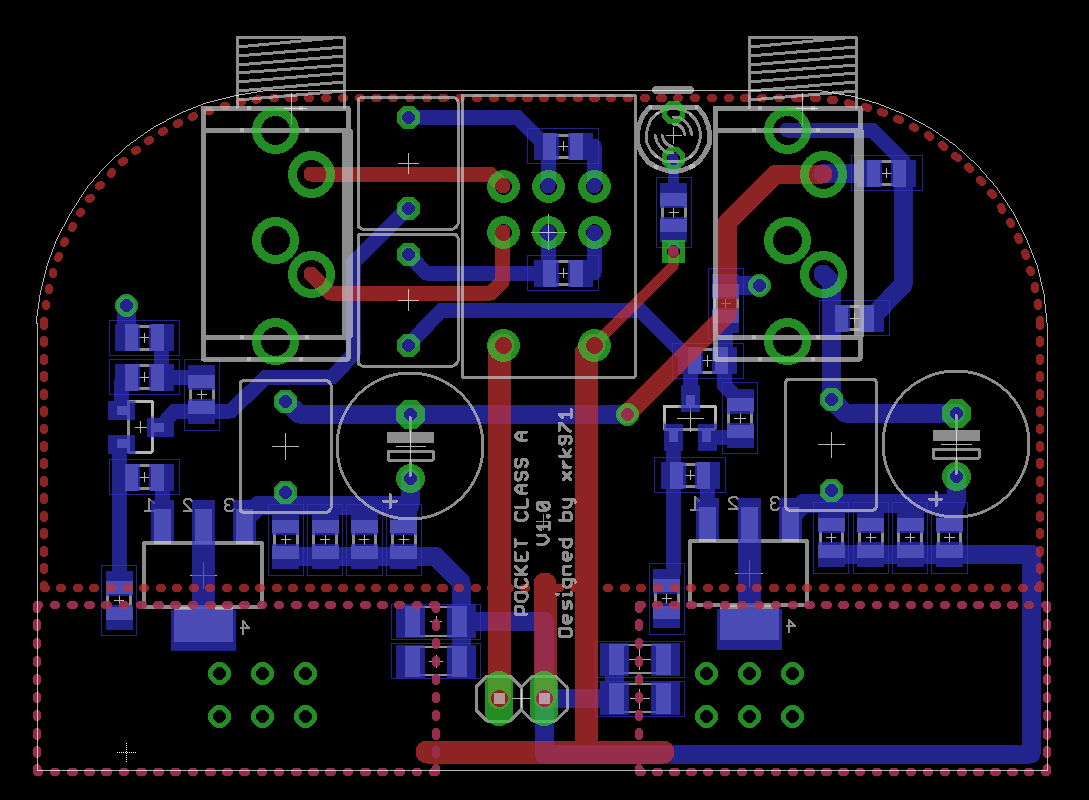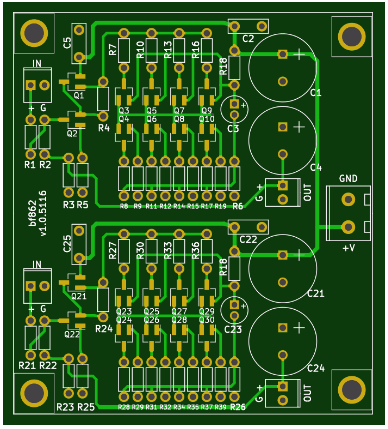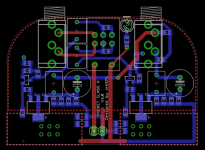Looking awesome!This amp is the real deal - no kiddin' around here - the above plots are seriously excellent in my opinion.
I've already done a through-hole version that will fit in the mint tin. However, I'm happy to do one for desktop use if you like, possibly full dual-mono.Baby, are you going to do a board with through-hole resistors? Personally, I don't care whether it fits into a can or not.
That's very nice. Thanks! Are we almost ready to go to print? I need to check circuit carefully.
I'd say we are

Exciting. As a noob I'm confused by some of the discussion in this thread about the output caps. Am I reading correctly that the cap value should be chosen based on the impedance of headphones to be used with the amp? I'm planning to use my 50 ohm Sennheiser HD 598 cans, a far cry from your beefy Beyers, X. Will I need to change anything? Also, I can't find it if you've posted it already...have you measured the output impedance of your Wintergreen amp? I've read some of NwAvGuy's blog posts about the 1/8th rule...
I don't know how to actually measure output impedance. It's something I can simulate and predict though. Regarding the output cap, then RC time constant as given in the formula previously by AndrewT let's you estimate it. But if the 47uF is good for 250ohm headphones then scale linearly for lower impedance. So 50ohm headphones should have 5x bigger or 150uF. Although there is some leeway as these are slow roll off slopes and we set them a decade below the needed bandwidth. You may find sufficient bass exists with even 100uF on 50ohm cans. The frequency response measurement was absolutely flat down to 20Hz within less than 0.5dB on 270ohm load.
Here is measurement of frequency response. I recall the sim showing things rolling off starting around 100Hz but measuremt doesn't seem to show this (at least not on this larger scale). This is a really flat response actually - textbook perfect. The rolloff on top is the sound card response I think.

Here is measurement of frequency response. I recall the sim showing things rolling off starting around 100Hz but measuremt doesn't seem to show this (at least not on this larger scale). This is a really flat response actually - textbook perfect. The rolloff on top is the sound card response I think.

Last edited:
BDHM,
The layout looks great. Are you using 2x100uF power rail smoothing caps like I had on mine? It's on the PCB thorough hole side. Also, I see a couple of resistors on the pot wiper - what is that for (or is that just the 100k resistors normally located elsewhere)? What kind of connector are you using for battery to PCB? I like those small snap in (Molex?) micro connectors. Straight soldered wires to PCB is not as good and if doing that we need 4 connections for the two battery terminal wires, tied in series.
Thanks,
X

The layout looks great. Are you using 2x100uF power rail smoothing caps like I had on mine? It's on the PCB thorough hole side. Also, I see a couple of resistors on the pot wiper - what is that for (or is that just the 100k resistors normally located elsewhere)? What kind of connector are you using for battery to PCB? I like those small snap in (Molex?) micro connectors. Straight soldered wires to PCB is not as good and if doing that we need 4 connections for the two battery terminal wires, tied in series.
Thanks,
X

Last edited:
If you look at the earlier versions you'll see the big electrolytic smoothing caps. I omitted them in the latest one just for clarity. So as things stand the power rails have 100-470uF electrolytic, 47uF ceramic and 100nF ceramic bypass for each channel.Are you using 2x100uF power rail smoothing caps like I had on mine?
Yup, those are the 100k resistorsAlso, I see a couple of resistors on the pot wiper - what is that for (or is that just the 100k resistors normally located elsewhere)?
The holes are standard 2.54mm pitch, so a Molex connector or pin header will fit just fine.What kind of connector are you using for battery to PCB?
I figured the series connection would happen on the battery side, but I'll see if I can fit a 4-waywe need 4 connections for the two battery terminal wires, tied in series.
Thanks Mlackey. If anyone is interested in a GB for this stereo board let me know. If I can get 5 people to go for two boards ea (two complete stereo systems) that would be critical mass. Cost includes shipping and will be $15 for CONUS and $22 for anywhere else in the world.

I'm interested in 2 of those boards if still applicable.
Thanks!
I don't know how to actually measure output impedance. It's something I can simulate and predict though. Regarding the output cap, then RC time constant as given in the formula previously by AndrewT let's you estimate it. But if the 47uF is good for 250ohm headphones then scale linearly for lower impedance. So 50ohm headphones should have 5x bigger or 150uF. Although there is some leeway as these are slow roll off slopes and we set them a decade below the needed bandwidth. You may find sufficient bass exists with even 100uF on 50ohm cans. The frequency response measurement was absolutely flat down to 20Hz within less than 0.5dB on 270ohm load.
Here is measurement of frequency response. I recall the sim showing things rolling off starting around 100Hz but measuremt doesn't seem to show this (at least not on this larger scale). This is a really flat response actually - textbook perfect. The rolloff on top is the sound card response I think.

Thanks for the info, X. I remember that when you switched to a smaller cap you noticed more midrange and treble clarity. Is that the trade-off? Sounds like for my 50 ohm headphones, I *might* get more bass extension with a 150uF cap but possibly better transparency on the top end with 100uF. Maybe I'll try both to see if I can hear a difference. Regarding the output impedance, what do your sims predict?
I'm interested in 2 of those boards if still applicable.
Thanks!

Group Buy for 10 JFET head amp:
- Pcgab 2 boards
If there was anyone else who PM'd me, I may have lost your name or forgotten - please just reply to this post with a quote and add your name.
I've already done a through-hole version that will fit in the mint tin. However, I'm happy to do one for desktop use if you like, possibly full dual-mono.
That would be awesome! If it isn't too much to ask, could you include the 5mm spaced pads for a larger volume pot? Something similar to what I use below.
I'm not a fan of the ALPS RK09 or any of the other small cheap pots.
Thank you!
Attachments

Group Buy for 10 JFET head amp:
- Pcgab 2 boards
If there was anyone else who PM'd me, I may have lost your name or forgotten - please just reply to this post with a quote and add your name.
I like that too
would you please link to schematic and price of pcb
1 pcb support stereo ?
I like that too
would you please link to schematic and price of pcb
1 pcb support stereo ?
http://www.diyaudio.com/forums/head...class-headamp-without-heat-8.html#post4942413
thank you for reply xrk
how would you compare SQ between 10 pcs BF862 HA version mentioned above,
version with BF862 and ZVN4306 mosfet http://www.diyaudio.com/forums/head...class-headamp-without-heat-6.html#post4944124
and F5 HA http://www.diyaudio.com/forums/group-buys/271926-f5-headamp-51.html#post4878879
and http://www.diyaudio.com/forums/group-buys/271926-f5-headamp-49.html#post4863764
appreciate your hard work
how would you compare SQ between 10 pcs BF862 HA version mentioned above,
version with BF862 and ZVN4306 mosfet http://www.diyaudio.com/forums/head...class-headamp-without-heat-6.html#post4944124
and F5 HA http://www.diyaudio.com/forums/group-buys/271926-f5-headamp-51.html#post4878879
and http://www.diyaudio.com/forums/group-buys/271926-f5-headamp-49.html#post4863764
appreciate your hard work
Last edited:
thank you for reply xrk
how would you compare SQ between 10 pcs BF862 HA version mentioned above,
version with BF862 and ZVN4306 mosfet http://www.diyaudio.com/forums/head...class-headamp-without-heat-6.html#post4944124
and F5 HA http://www.diyaudio.com/forums/group-buys/271926-f5-headamp-51.html#post4878879
and http://www.diyaudio.com/forums/group-buys/271926-f5-headamp-49.html#post4863764
appreciate your hard work
Jeez, that's a lot of head amps! LOL
Ok let's give them names and summary descriptions:
1. 10 x BF862 JFET (SE AC coupled)
2. Pocket Class A (BF862 & ZVN4306) (SE AC coupled)
3. F5 Prasi layout with IRF610/9610 (Push-pull complementary DC coupled)
4. F5 Prasi layout with 2SK2013/2SJ313 (Push-pull complementary DC coupled)
I will add a 5th, 6th, 7th, 8th, 9th:
5. 4 x BF862 JFET (AC coupled SE Class A - Tea Box Amp)
6. BF862 & LU1014D SE Class A (AC coupled)
7. Juma BJT (DC coupled complementary push - pull)
8. Salas DCG3 (DC coupled SE output and JFET differential LTP input)
9. DAO with Juma BF862 preamp (DC coupled SE output with AC coupled SE preamp)
They have very different sonic signatures as a result of the topology. The first two are single ended and have characteristic SE sound of slightly higher H2 vs H3 but the 10 JFET one has very strict matching requirements to get as clean sounding as the Pocket Class A. The 4 JFET variant is much easier to match with only 3 needed to match in Idss and Vgs at operating point. I prefer sonic signature if the simple SE amps over the complementary push pull. But if you really crave for HF detail and resolution - the DC coupled push-pull amps have more zing. The SE amps have no lack of bass authority. The LU1014D based one has the most powerful bass - perhaps too much so. Between 3 & 4 the difference in the IRF610/9610 and Toshiba 2SK2013/2SJ313 is very marginal and go with the IRF's as they are plentiful and easier to try to match Vgs on N and P channel. This simple Prasi F5 is an excellent amp to get info DV coupled head amps but be careful with output DC offset. They drift up to 30 mV with temperature. If a part or supply rail lets go your cans are toast with 12v to 15v applied to the wispy little voicoils. I lost my left channel can on MDRV6 for this.
Overall, my current favorite is the Pocket Class A for its sound signature. It measures amazingly clean as well. Just a nice sounding amp I can listen to forever.
But if I need extra "detail" I like the F5's or my new Salas DCG3 which goes to 3MHz and is DC coupled and SE output! A nice amp.
I guess that is amp number 8.
There is also the DAO source follower that is DC Coupled output with LU1014D and IRFP240. Thatbone had very powerful bass and great overall dynamics. Although DC coupled outputs I am not as worked about DC offset as it is very stable.
There's a couple more in the works. A BJT output version of the Pocket Class A.
Last edited:
XRK
what a description
thank you very much
http://www.diyaudio.com/forums/head...lass-headamp-without-heat-10.html#post4953548 represent pocket class A ?
any chance to do a GB for that
PS what about crossfeed - Is there a benefit from using It
what a description
thank you very much
http://www.diyaudio.com/forums/head...lass-headamp-without-heat-10.html#post4953548 represent pocket class A ?
any chance to do a GB for that
PS what about crossfeed - Is there a benefit from using It
That would be awesome! If it isn't too much to ask, could you include the 5mm spaced pads for a larger volume pot?
Sure thing
- Home
- Amplifiers
- Headphone Systems
- BF862 based SE Class A Headamp without the HEAT




